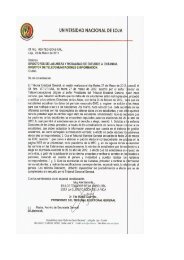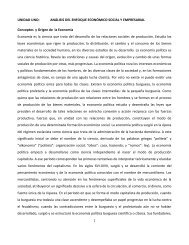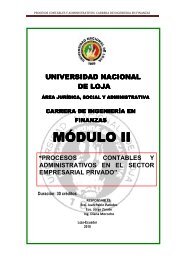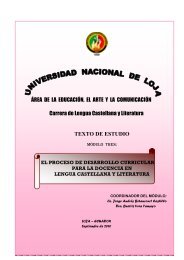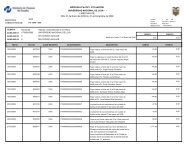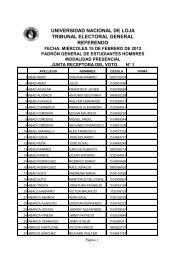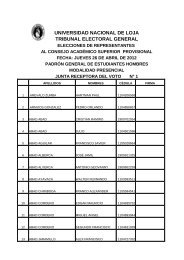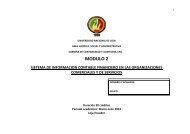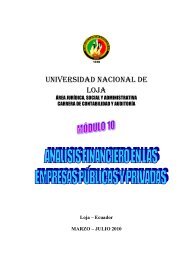module 5 planning of the english language teaching-learning process
module 5 planning of the english language teaching-learning process
module 5 planning of the english language teaching-learning process
You also want an ePaper? Increase the reach of your titles
YUMPU automatically turns print PDFs into web optimized ePapers that Google loves.
UNIVERSIDAD NACIONAL DE LOJA<br />
Área de la Educación el Arte y la Comunicación<br />
English Language Career<br />
learners' needs during <strong>the</strong> lesson.<br />
3 Writing a lesson plan is <strong>the</strong> important thing. I always have a written plan, but<br />
<strong>of</strong>ten I don't look at it while I'm <strong>teaching</strong>.<br />
PRACTICE TASK<br />
For questions 1-7 match <strong>the</strong> stages <strong>of</strong> <strong>the</strong> lesson with <strong>the</strong> subsidiary aims<br />
listed A-H. There is one extra option which you do not need to use.<br />
Lesson stages<br />
1. Check vocabulary from <strong>the</strong> last lesson.<br />
2. Introduce <strong>the</strong> topic and elicit / present new words and phrases.<br />
3. Learners reorder jumbled paragraphs <strong>of</strong> a text.<br />
4. Learners match words in <strong>the</strong> text with possible meanings.<br />
5. Learners answer true or false questions.<br />
6. Learners underline examples <strong>of</strong> report speech.<br />
7. Learners exchange text and give feedback.<br />
Subsidiary<br />
A. Focus on form.<br />
B. Deducing meaning from context.<br />
C. Peer correction.<br />
D. Check detailed comprehension.<br />
E. Contextualize and pre-teach vocabulary.<br />
F. Check learners awareness <strong>of</strong> text organization (pronouns, linking, etc)<br />
G. Controlled practice <strong>of</strong> target structure.<br />
H. Revise <strong>language</strong> already learnt.<br />
Planning an individual lesson or a sequence <strong>of</strong> lessons<br />
• How do we plan an individual lesson or a sequence <strong>of</strong> lessons?<br />
When we plan an individual lesson, we need to think about its aims, <strong>the</strong> 'shape'<br />
<strong>of</strong> <strong>the</strong> lesson and <strong>the</strong> kind <strong>of</strong> techniques that are most appropriate for a<br />
particular group <strong>of</strong> learners. For example, if we are introducing a new<br />
grammatical structure, we might choose a Presentation, Practice and<br />
Production (PPP) approach or a Task-based Learning (TBL) approach. Skills<br />
lessons, too, have regular shapes that we can use to organize lesson plans: for<br />
example, for receptive skills, we usually plan tasks or activities for learners to do<br />
before, while and after reading or listening; for productive skills, <strong>the</strong>re is usually<br />
an introductory stage to set <strong>the</strong> scene (i.e. to explain <strong>the</strong> context) and a<br />
feedback stage after <strong>the</strong> speaking or writing activity.<br />
We also need to think about <strong>the</strong> connections between <strong>the</strong> aims <strong>of</strong> <strong>the</strong> lesson<br />
and <strong>the</strong> procedures we will use to achieve those aims. The available materials,<br />
<strong>the</strong> length <strong>of</strong> <strong>the</strong> lesson and <strong>the</strong> information we have about our learners will all<br />
[Escribir texto] Página 54



